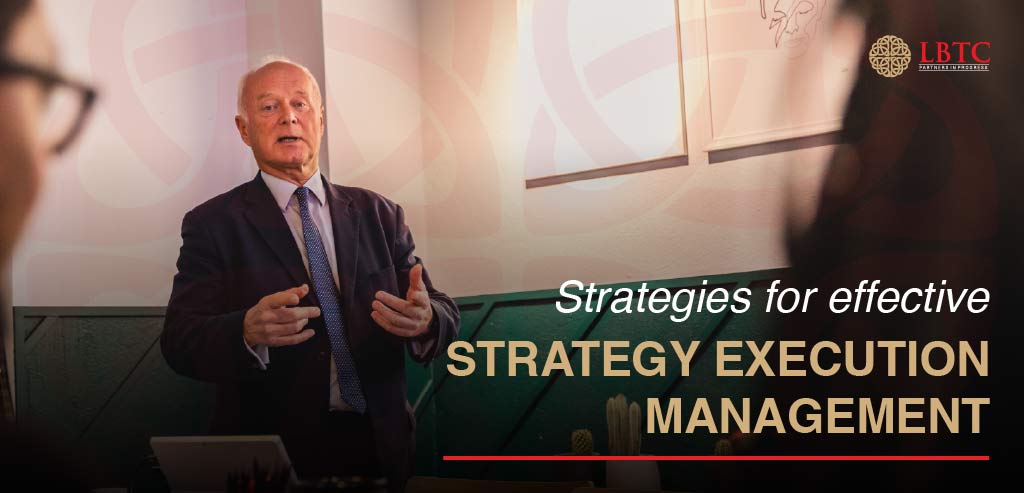
Executing your strategy well is essential to making your business vision a reality. This blog series explores the tactics, recommended procedures, and typical obstacles you may face during this crucial journey.
Think of this as an introductory essay that provides a preview of more in-depth discussions on upcoming subjects. Now, let’s go into some doable tactics that will help you improve the way you execute your strategies.
The Foundation: Understanding Strategy Implementation Management
A clear knowledge of what a plan comprises is essential to its successful execution. It is, essentially, the process of successfully implementing your strategic plans. This entails assigning resources, coordinating projects, and making sure that every member of your organisation is committed to the strategy’s success.
Problems in the Way: Typical Difficulties in Putting Strategies Into Practice
The implementation of a strategy can be complex and fraught with difficulties. Let’s address these issues directly, with some real-world instances to highlight their significance afterward:
First Challenge: The Alignment Pit
The foundation of a good execution is alignment. Without it, your company functions like a ship without a compass. Teams and departments may not get along, which wastes resources and results in inefficiency.
Case Study: Manufacturing Misalignment
Let’s demonstrate this challenge using a made-up situation. Suppose that “Company X,” a multinational producer, announces a calculated plan to reduce manufacturing expenses by fifteen per cent in a year. But when they execute, they find that departments are not aligned. There are delays in production, which has a negative financial impact. The most important lesson learned? For an execution to be effective, alignment is essential.
Second Challenge: The Ambush of Accountability
Defined accountabilities are necessary to prevent misunderstandings and guarantee that projects and tasks proceed according to schedule. Projects can stop due to unclear duties, which could result in delays and failures.
Case Study: Digital Transformation in Healthcare
Here’s an additional made-up example to help you understand this difficulty. Healthcare Organisation Y sets out on a journey of digital transformation with the goal of improving patient care and cutting expenses. Their difficulty, nevertheless, comes from the requirement for distinct accountabilities. Patient services are impacted when project milestones are missed due to unclear roles. This emphasises how crucial it is to have distinct accountabilities.
Putting Yourself in Position for Success: Techniques for Using Strategies Effectively
Take into account these crucial strategies to get past these obstacles and improve the way your approach is executed:
Aligning strategy and execution: It is essential since it guarantees that all members of the organisation are heading in the same direction. As a result, silos and turf conflicts are eliminated, resulting in a more organised and successful plan implementation process. Aligning goals and resources with the use of tools like the Hoshin Kanri x-matrix offers a clear execution plan.
Clearly defined responsibilities: Precise accountability is necessary for a strategy to be executed well. Projects proceed more smoothly, and there is less uncertainty when teams and individuals are aware of their duties. Setting specific, quantifiable goals and allocating accountability can be done with the use of tools like Objectives and Key Results (OKRs).
Goals in Cascades: Organising goals in a way that cascades throughout the whole group promotes cohesion and unity. It guarantees that workers comprehend how their efforts fit into the overall plan. Workers can participate in goal-setting and coordination through methods like the catchball technique.
Openness Is Essential: Sustaining transparency is essential to the effective implementation of a strategy. Sharing developments, triumphs, and difficulties on a regular basis with all parties involved keeps everyone updated and involved. A crucial component of the catchball process, which entails constant discussion and criticism, is transparent communication.
Best Practices in Strategy Execution Management: A Case Study of the Best.
Executing strategies well is a strength of some companies. From their success stories, the following recommended practices have been identified:
Ownership and Accountability.
Effective companies give each goal a distinct owner in order to maintain focus and alignment. This guarantees that each strategic goal has a single owner who is in charge of carrying it out
Contingent Goals.
They cascade goals throughout groups and individuals, requiring everyone to participate in the implementation of the strategy. This guarantees that each worker is aware of their part in accomplishing the strategic objectives.
Constant Communication.
Teams and individuals remain aligned with execution goals through regular, clear communication. Continuous communication and feedback loops are part of this to make sure everyone is in agreement.
Metrics and the Evaluation of Success.
It’s critical to measure strategy execution success. Key Performance Indicators (KPIs) are a useful tool for monitoring progress and gaining vital insights into the execution of your strategy. Financial goals, project milestones, employee involvement, customer happiness, and more are examples of common KPIs. The KPIs you select should show progress towards your strategic goals and be in line with them. KPI data can be regularly reviewed and analysed to enable necessary revisions and enhancements.
The Conclusion
You may effectively negotiate obstacles, promote execution excellence, and ultimately accomplish your strategic goals by implementing these tactics and best practices into your strategy execution management.
Are you prepared to go further? Watch this space for further in-depth discussions of specific execution barriers and other tactics in upcoming editions of this series. To learn more about the creation and implementation of strategies, take into consideration registering for one of our strategic management courses in the meantime. Let’s work together to close the gap that exists between clear outcomes and strategic vision.

Leave a Reply